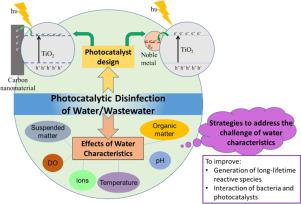Science of the Total Environment ( IF 8.2 ) Pub Date : 2020-12-04 , DOI: 10.1016/j.scitotenv.2020.143953 Juhua He , Ashutosh Kumar , Musharib Khan , Irene M.C. Lo

|
This critical review covers ways to improve TiO2-based photocatalysts, how water characteristics may affect photocatalytic disinfection, and strategies to tackle the challenges arising from water characteristics. Photocatalysis has shown much promise in the disinfection of water/wastewater, because photocatalysis does not produce toxic by-products, and is driven by green solar energy. There are however several drawbacks that are curbing the prevalence of photocatalytic disinfection applications: one, the efficiency of photocatalysts may limit popular utilization; two, the water characteristics may present some challenges to the process. TiO2-based photocatalysts may be readily improved if composited with noble metals or carbon nanomaterials. Noble metals give TiO2-based composites a higher affinity for dissolved oxygen, and induce plasmonic and Schottky effects in the TiO2; carbon nanomaterials with a tunable structure, on the other hand, give the composites an improved charge carrier separation performance. Other than photocatalyst materials, the characteristics of water/wastewater is another crucial factor in the photocatalysis process. Also examined in this review are the crucial impacts that water characteristics have on photocatalysts and their interaction with bacteria. Accordingly, strategies to address the challenge of water characteristics on photocatalytic disinfection are explored: one, to modify the semiconductor conduction band to generate long-lifetime reactive species; two, to improve the interaction between bacteria and photocatalysts.
中文翻译:

细菌光催化消毒的批判性综述:从贵金属和碳纳米材料-TiO 2复合材料到水特性挑战和战略解决方案
这篇重要的评论涵盖了改善基于TiO 2的光催化剂的方法,水的特性如何影响光催化消毒以及应对水特性带来的挑战的策略。光催化在水/废水消毒中显示出很大的希望,因为光催化不会产生有毒的副产品,而是由绿色太阳能驱动。但是,有几个缺点正在抑制光催化消毒应用的普及:一是光催化剂的效率可能会限制人们的普遍使用。第二,水的特性可能给工艺带来一些挑战。如果与贵金属或碳纳米材料复合,则基于TiO 2的光催化剂可以很容易地得到改善。贵金属产生TiO 2基复合材料对溶解氧具有更高的亲和力,并在TiO 2中引起等离子体和肖特基效应。另一方面,具有可调结构的碳纳米材料使复合材料具有改进的电荷载流子分离性能。除光催化剂材料外,水/废水的特性是光催化过程中的另一个关键因素。在这篇综述中还检查了水特性对光催化剂及其与细菌相互作用的关键影响。因此,探索了解决水特性对光催化消毒的挑战的策略:一,修改半导体导带以产生长寿命的反应物种。二是改善细菌与光催化剂之间的相互作用。











































 京公网安备 11010802027423号
京公网安备 11010802027423号